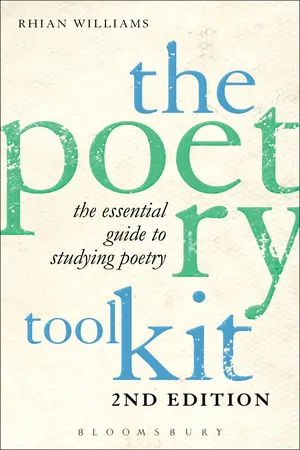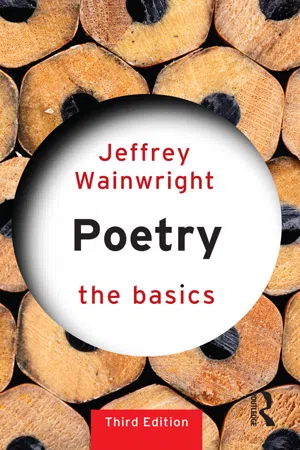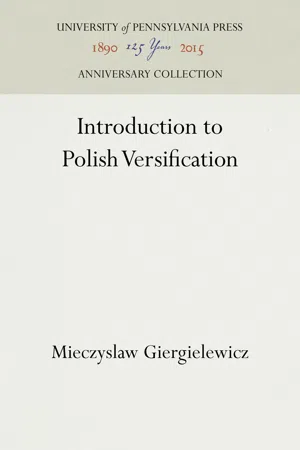Literature
Stanza
A stanza is a group of lines in a poem that form a unit within the larger structure of the poem. It is often separated from other stanzas by a space and typically has a consistent number of lines and a specific rhyme scheme or meter. Stanzas help to organize the content of a poem and contribute to its overall rhythm and meaning.
Written by Perlego with AI-assistance
6 Key excerpts on "Stanza"
- eBook - PDF
- Rhian Williams(Author)
- 2013(Publication Date)
- Bloomsbury Academic(Publisher)
It is particularly prevalent in the ballad tradition, and in the fixed French forms such as the villanelle and the ballade , but they also feature in lyric poems Stanza A group of poetic lines, defined by its arrangement of metre and rhyme . Feet, lines and rhymes of poetry have been considered; now we come to how all of these features come together into particular poetic arrangements. ‘Stanza’ is the name given to blocks of formal poetry; commonly these blocks are called ‘verses’ (especially with reference to songs), but Stanza is clearer. (Note however that in blank verse such divisions are known as verse paragraphs .) ‘Stanza’ is often etymologically linked via Latin to the Italian for ‘stopping place’, but the term also applies in Italy to a chamber or room and this latter root is more helpful in thinking about the definition of a Stanza of poetry. We may think that a room is most obviously defined by its function and content (beds in bedrooms; ovens in kitchens). Framing this functional definition, however, is a room’s dimensions (the length of its walls) and its decor. A Stanza’s line lengths may be likened to its ‘walls’ (which form a particular set of dimensions on the page) and the rhyme scheme , which decorates the line lengths, becomes the wallpaper. In this section Stanzas are arranged primarily in terms of their dimensions – the number of lines included in each – since all Stanzas may be described most simply in this way. In certain fixed or named Stanza arrangements the rhyme scheme or metre is specified, so these are also given in each definition. 5.1 One-line Stanzas and refrains Stanza 183 as a case of heightened or concentrated emotion. A famous example is Alfred Tennyson’s ‘Lady of Shalott’ (1832), in which the subject’s name is repeated as a refrain in the final line of every Stanza . - Whilst the reader might want to argue that the Stanza is not really a visual effect, certainly not of the kind we have discussed so far, it matters here because all Stanzaic forms when ren-dered in print address themselves to the reading eye. Even people supposedly well informed about poetry (such as the authors of this book) would be hard put to give an accurate description of a poem’s Stanzaic form merely through hearing the work being read aloud. A poem’s Stanzaic form is most evident when it is encountered in its visual dimension. 34 Poetry Perhaps the most notable aspect of the visual organisation of poetry on the printed page is the division of many poems into groups of lines, or ‘Stanzas’: She dwelt among the untrodden ways Beside the springs of Dove, A Maid whom there were none to praise And very few to love: A violet by a mossy stone Half hidden from the eye! Fair as a star, when only one Is shining in the sky. She lived unknown, and few could know When Lucy ceased to be; But she is in her grave, and oh, The difference to me! (Wordsworth) A Stanza is a subdivision or section of a poem, and a poem’s Stanzas generally share the same line-length, rhyme scheme and poetic metre. Pauses between Stanzas are marked by a space line on the printed page. A poem divided into Stanzas is thus referred to as ‘Stanzaic’. The term ‘verse’ is not infrequently used for Stanza, especially with reference to the lyrics of pop songs or hymns, but should perhaps be avoided, given that a verse is more properly a single line of a poem.
- eBook - ePub
- Jeffrey Wainwright(Author)
- 2015(Publication Date)
- Routledge(Publisher)
7 StanzaLet me hear a staff, a stanze, a verse.(Shakespeare, Love’s Labour’s Lost , Act IV Sc. 2)When the comic character Holofernes makes this demand he is either showing off by using three words where one will do, or he is uncertain which word to use. He wants Nathaniel to read him some poetry and in the 1590s the word Stanza , to refer to a grouping of lines, was quite new in English. But, with the sixteenth century’s attraction to Italian models, it was coming to displace the Old English word staff . The French word verse , then as now, could refer to a group of lines, a single line, or simply mean poetry in the generic sense.After Nathaniel has read a dozen or so lines Holofernes interrupts him complaining ‘You find not the apostrophus, and so miss the accent’, in other words he is missing the correct places to pause. As we have seen, timing is essential to all aspects of the rhythm of poetry both for its sense and effects, so the ‘apostrophus’ – the pause – is vital.Definitions
The original sense of Stanza in Italian is ‘stopping-place’, a place to take a stand, and more particularly ‘room’. These associated senses are exactly appropriate to the established sense of Stanza in poetry. A poem in Stanzas is one comprising a series of groups of lines shaped in the same way, and usually, although not always of the same length. As each group ends, the poem has a momentary stopping-place. The structure of each Stanza itself provides a space for the words to work, for what, in his overblown way, Holofernes calls ‘the elegancy, facility and golden cadence of poetry’.For the American poet Kenneth Koch (1925–2002) a Stanza is ‘nothing more than organizing other forms of poetic music – rhythm and rhyme’ (Making Our Own Days - eBook - PDF
- Mieczyslaw Giergielewicz(Author)
- 2015(Publication Date)
7 A W V W W W W W r t V W W V Stanzas 1. Origin and growth Lines of poetry may be organized without a break or divided into uniform groups called Stanzas. Another arrange-ment is the dissection of the poetic text into irregular groupings of different length. This last organization seems to prevail in modern poetry. In the history of Polish versification stranzas have played an important part. The collective volume Strofika, edited by Maria R. Mayenowa, 1 listed almost one thousand varieties, although it did not include Stanzas that could appear as self-contained poems like the sonnet, the rondeau, and the triolet. Three external influences contributed to the formation of Polish Stanzas. First, a few forms were derived from ancient literatures as, for example, the Sapphic quatrain. Secondly, the influence of medieval Latin poetry was apparent. Last but not least, the abundant Romance literature of the Middle Ages had its impact. Besides this, there were other minor stimuli, such as oriental poetry, which penetrated Poland by various channels. Close correlation between poetry and music was of paramount importance; it contributed to the adoption of the refrain, which was a commonly used Stanza-making device. 1 Strofika. Praca zbiorowa pod redakcj^ Marii Renaty Mayenowej (Poetyka, zarys encyklopedyczny. Dzial III. Wersyfikacja, T o m VI. Strofika) (Wroclaw, 1964), 422 p. 146 Stanzas 1 4 7 The history of Polish literature covers wide fluctuations in poets' interest in the Stanza. In this respect Kochanowski was quite productive. His work contained 46 different types of Stanza ranging from 2 to 14 lines. Baroque poetry, especially in its earlier period, added a considerable number of new forms. In the eighteenth century this fertility waned, as the Classicists were more concerned about other facets of poetics. The Romanticists revived interest in the Stanza. Oxytonic rhyming and the development of the syllabic-accentual system provided other elements for Stanza making. - eBook - PDF
- Christiana Gregoriou(Author)
- 2017(Publication Date)
- Red Globe Press(Publisher)
CHAPTER 1 Naming Poetic Parts ❚ 1.1 Analysing poetry When it comes to poetry, stylisticians, much like literary critics, are concerned with explaining how the poem’s form and structure contributes to the effects that it generates, and the ways in which the poem expresses the poet’s ideas. However shared their tasks, the two sets of different commentators neverthe-less operate at rather different levels of abstraction (Leech, 1969: 6). As noted in the previous chapter, a stylistician is more concerned with explaining in objec-tive and reliable terms the way in which the language of the poem particularly contributes to its meaning. And it is for this reason that stylisticians often start by outlining their initial impressions of a text, after which they proceed to engage in detailed and systematic linguistic analysis of the art form to justify or explain these original intuitions. But what makes poetry special or different from other literary art forms? The OED defines poetry as the ‘composition in verse or some comparable patterned arrangement of language in which the expression of feelings and ideas is given intensity by the use of distinctive style and rhythm’. What appear to differen-tiate poetry from other imaginative, creative, or indeed fictional literary art forms are the notions of ‘intensity’ or emotional impact, coupled with ‘style’ and ‘rhythm’ in potentially ‘verse’ form. Therefore, one of the things we should consider is how to go about describing these ‘verses’, their ‘rhythm’ and their accompanying ‘intensity’. ❚ 1.2 Rhythm and metre ‘Rhythm’ is something we perceive in many things, such as the beating of our hearts, the sound of a machine, or indeed music. It is essentially a pattern of stresses, the perception human beings have of ‘on’ and ‘off’ beats, strong and weak ones, correspondingly referred to as the ‘ictus’ (/) and the ‘remiss’ (X). - eBook - PDF
- John Singleton, Mary Luckhurst, John Singleton, Mary Luckhurst(Authors)
- 2000(Publication Date)
- Bloomsbury Academic(Publisher)
The lines, and the groups, may be regular in one or another way, as in limericks and sonnets; or they may be irregular, creating a new form 164 WRITING VERSE 165 unique to that poem: but in all cases there is a form, so again the choice is not whether to have a form, but whether you attend to the form. Poetry has varied enormously over time (as you can see by paging through the Norton Anthology), and because people have often been taught poetry narrowly at school there are common misconceptions about 'what poetry is'. Before the twentieth century most poetry in English was written in regu-lar metres (or patterns of stress), so that each line has a similar rhythm; and in prescribed forms, so all the lines are either of the same length, or vary in a regular way. Poems of this kind often have a regular pattern of end-rhymes (called the rhyme scheme): but this does not mean that 'all poems rhyme', nor that 'if it rhymes it's a poem'; and in the twentieth century (especially since T. S. Eliot's The Waste Land [1922]: N1236) free verse (where the metrical pattern varies from line to line) and open form (where the line lengths and rhyme scheme are ir-regular) have become increasingly popular. There is still metre, and form: but they are freed from preset rules and limits. You may want to write more traditional poetry (and many poets, like Tony Harrison, have continued to use regular metres and forms), or you may want to experiment with free verse, but in either case you will need to understand metre and form, to make them regular or to control their irregularities. Metre and form are very general terms, and each can be subdivided in many ways (some of which are explored in the Workshop Writing and Writing On sections).
Index pages curate the most relevant extracts from our library of academic textbooks. They’ve been created using an in-house natural language model (NLM), each adding context and meaning to key research topics.





